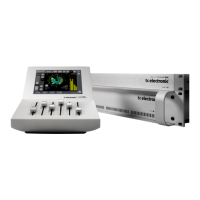54
paGe Headsample raTe COnVersIOn fIlTers - ada 24/96
Sample Rate Conversion Filters
Introduction
The Delta-Sigma Converters of the ADA 24/96 operate
at 6.144MHz (48/96kHz sample rate) or 5.6448MHz
N+]DWWKHHQGVIDFLQJWKHDQDORJZRUOG%XW
the processing, transmission and storage of high-quality
audio material are often done at 48 or 44.1kHz. Conversion
to/from this low sample rate involves a series of digital
filters removing the signal components above one half the
sampling frequency (the Nyquist frequency) at all points
in the chain. The properties of the lowest filter stage
converting to/from 44.1 or 48kHz has profound influence
on sound quality, and getting down to 44.1kHz digital and
EDFNWRDQDORJZLWKRXWVHYHUHORVVRI³DLU´WUDQVSDUHQF\
and spatial definition is usually considered impossible.
Furthermore, experience suggests that the optimum design
of this critical filter is program material dependent. And of
course there is always the matter of taste.
Therefore, when we designed the ADA 24/96, we did
not just do a careful circuit design around a set of
state-of-the-art 24-bit converter chips. We threw in the
powerful Motorola 56303 DSP chip as well, enabling us to
offer you a choice of different, carefully optimized filters for
the super-critical conversion stage from 96 to 48kHz.
The 5 different filter types described below have been
optimized individually for each of the two target sampling
rates (44.1 and 48kHz), enabling us to take full advantage
of the (comparatively) more relaxed design conditions at
N+]7KHRSWLPL]DWLRQLQYROYHG$%FRPSDULVRQWRD
direct analog transmission of live musical instruments.
Linear phase - non linear phase
When aiming for perfect sound reproduction, the best one
FDQKRSHIRULVD³VWUDLJKWZLUH´1RWKLQJDGGHGQRWKLQJ
removed and nothing changed. The output waveform is an
exact replica of the input waveform. In technical terms this
means
,QILQLWHVLJQDOWRQRLVHUDWLRDQGQRGLVWRUWLRQ
/LQHDUSKDVHUHVSRQVH³IURP'&WROLJKW´
'HDGIODWPDJQLWXGHUHVSRQVH³IURP'&WROLJKW´
How does digital audio transmission and processing score
compared to this ideal?
:LWKVWDWHRIWKHDUWELWFRQYHUWHUVDQGQROHVVWKDQ
24-bit processing, the signal-to-noise ratio today is
VXIILFLHQWO\FORVHWR³LQILQLWH´DQGZLWKSURSHUGLWKHULQJ
distortion is no longer considered a problem, even at low
levels.
/LQHDU3KDVHLVHDVLO\REWDLQHG3HUIHFWGLJLWDOWUDQVPLV
sion is essentially just copying or storing and retrieving
numbers, and if filtering is required, linear-phase FIR
filters are the simplest kind.
7KH6DPSOLQJ7KHRUHPSXWVDGUDPDWLFUHVWUDLQWRQ
bandwidth: Any remaining signal components above the
Nyquist frequency (only 22.05 kHz at 44.1 kHz sampling
rate) turn into aliasing. Therefore the magnitude
response has to drop sharply just above 20 kHz.
So far most designers of digital audio equipment have
settled for 2 out of 3: Fought noise as best they could
and kept the phase response linear. However, when the
FRQGLWLRQVFKDQJHVRGUDPDWLFDOO\IURP³,GHDO´WR³+DYLQJ
WRJLYHXSRQRQHJRDORXWRIWKUHH´WKHUH¶VQRODZVD\LQJ
WKDWWKHRWKHUWZRJRDOVGRQ¶WPRYH$QGDFFRUGLQJWR
RXUH[SHULHQFHWKHOLQHDUSKDVHJRDOGRHVLQGHHGPRYH
Given the necessity of a sharp hi-cut filter, a perfectly linear
SKDVHUHVSRQVHLVQRWRSWLPDO
With a bit of mathematical and psycho-acoustical
reasoning, this is not surprising:
The sharp hi-cut filter is bound to add a lot of ringing to the
system’s impulse response. The phase response affects
WKHGLVWULEXWLRQRIWKHULQJLQJLQWLPH/LQHDUSKDVHLPSOLHV
a time-symmetric impulse response with equal amounts of
ringing before and after the actual impulse. Human hearing
is not time-symmetric, as anyone who has ever played a
tape backwards will know. On the other hand, we are not
insensitive to phase distortion either, so a compromise has
to be found.
The Filters
Through weeks of repeated listening tests and phase, as
well as magnitude response adjustments, we came up with
WKH1DWXUDODQG9LQWDJHILOWHUVWKDWXVHVOLJKWO\QRQOLQHDU
phase responses.
The filters include some that are aliasing-free in the sense
that they achieve full attenuation at the Nyquist frequency
where aliasing starts to occur, as opposed to the cheaper
KDOIEDQGILOWHUVRIWHQXVHGWKDWDUHRQO\G%GRZQDWWKH
Nyquist please see fig. 1 and 2.
Fig. 1

